Gujarat Board GSEB Textbook Solutions Class 12 Biology Chapter 6 Molecular Basis of Inheritance Textbook Questions and Answers, Additional Important Questions, Notes Pdf.
Gujarat Board Textbook Solutions Class 12 Biology Chapter 6 Molecular Basis of Inheritance
GSEB Class 12 Biology Molecular Basis of Inheritance Text Book Questions and Answers
Question 1.
Group the following as nitrogenous bases and nucleosides:
Adenine, Cytidine, Thymine, Guanosine, Uracil and Cytosine.
Answer:
Adenine, thymine, uracil and cytosine are nitrogenous bases and cytidine and guanosine are nucleosides.
![]()
Question 2.
If a double stranded DNA has 20 percent of cytosine, calculate the percent of adenine in the DNA.
Answer:
The percentage of cytosine is 20. Cytosine always pairs with guanine. So the percentage of cytosine and guanine is 40 (20 + 20). The remaining 60% is for both adenine and thiamine which also pair in equal proportion. So the percentage of adenine is 30 (30 + 30).
Question 3.
If the sequence of one strand of DNA is written as follows:
5′ -ATGCATGCATGCATGCATGCATGCATGC- 3′
Write down the sequence of complementary strand in 5′ → 3′ direction.
Answer:
5’ -TACGTACGTACGTACGTACGTACGTACG- 3′
![]()
Question 4.
If the sequence of the coding strand in a transcription unit is written as follows:
5′ -ATGCATGCATGCATGCATGCATGCATGC- 3′
Write down the sequence of mRNA.
Answer:
m RNA carries the same code as the coding strand except T is replaced by U.
(Question) transcription strand 5′ – ATGC ATGC ATGC ATGC ATGC ATGC ATGC – 3′ m RNA → 5′ – AUGC AUGC AUGC AUGC AUGC AUGC AUGC – 3′.
Question 5.
Which property of DNA double helix led Watson and Crick to hypothesise semi-conservative mode of DNA replication? Explain.
Answer:
Watson and Crick in 1953 explained that the specific pairing of nitrogenous bases in a DNA strands, enable the two strands to separate and act as a template for the synthesis of new complementary strand. This scheme is known as semiconservative method of DNA replication.
Question 6.
Depending upon the chemical nature of the template (DNA or RNA) and the nature of nucleic acids synthesized from it (DNA or RNA), list the types of nucleic acid polymerases.
Answer:
DNA Template
- DNA polymerases for DNA replication.
- RNA polymerases for RNA synthesis or transcription
RNA Template
- RNA-dependent RNA polymerases for the synthesis of RNA are some RNA viruses.
- Reverse transcriptase to synthesize DNA over RNA template.
![]()
Question 7.
How did Hershey and Chase differentiate between DNA and protein in their experiment while proving that DNA is the genetic material?
Answer:
A.D.Hershey and M.Chase (1952) studied the T2 phage infecting E.coli (A virus that infects bacterium is called a bacteriophage). A bacteriophage has two components DNA and protein. After infection the virus multiplies within the bacterium. The T2 progeny are released by the lysis of the bacterial cell. The T2 phage has two components namely a DNA core and a protein sheath. Hershey and Chase tried to find out which is the genetic material.
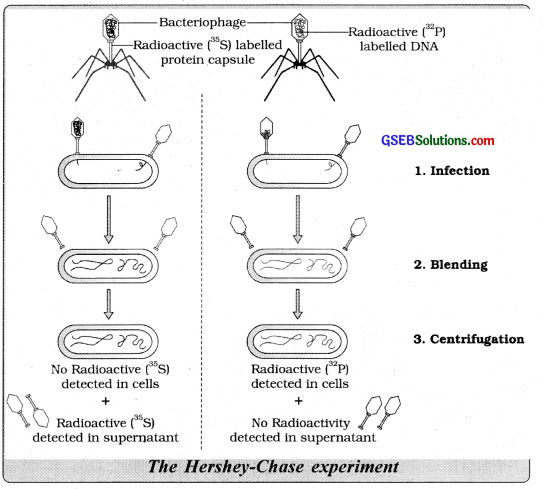
Hershey and Chase made two preparations of T2 phage. In one preparation the proteins were labelled with S35. In the second preparation the DNA was labelled with P32. They were used separately to infect E.coli. After infection the E.coli cells were gently agitated in a blender to separate the phage particles from the bacteria. Then the culture was centrifuged. The heavier bacterial cells formed as a pellet at the bottom. The lighter viral components outside the bacterial cells remained in the supernatant.
Hershey and Chase found that the supernatant contains viral protein labelled with S35. This showed that the viral proteins had not en- tered the bacterial cells during infection. But when the viral DNA was labelled using P32 the radioactivity was found in the bacterial pellet. This indicates that the viral DNA entered the bacterial cell during infection. This viral DNA causes the multiplication of the phage inside the bacterium. Thus they experimentally proved that DNA is the genetic material.
![]()
Question 8.
Differentiate between the followings:
a. Repetitive DNA and Satellite DNA
b. mRNA and tRNA
c. Template strand and Coding strand
Answer:
a. Repetitive sequences are stretches of DNA sequences that are repeated many times, sometimes hundred to thousand times. When the repetitive DNA sequences are separated from bulk genomic DNA as different peaks during density gradient centrifugation, the bulk DNA forms major peak and the other small peaks are referred to as satellite DNA.
b. mRNA or messenger RNA is transcribed from DNA. It carries the genetic information from DNA to the ribosomes for protein synthesis. tRNA or transfer RNA is the smallest RNA. It has a triplet code which is complementary to the codon in the mRNA. It carries amino acids to the site of protein synthesis.
c. The strand with polarity 3′ → 5′ acts as a template during DNA synthesis. This strand is called template strand. The strand which does not code for anything is called coding strand.
![]()
Question 9.
List two essential roles of ribosome during translation.
Answer:
- Ribosome is the cellular factory for synthesizing proteins.
- Ribosome acts as a catalyst in bacteria for the formation of peptide bond.
Question 10.
In the medium where E. coli was growing, lactose was added, which induced the lac operon. Then, why does lac operon shut down some time after addition of lactose in the medium?
Answer:
Due to a decrease in lactose substrate concentration, lac operon shuts down as it is an inducible operon.
Question 11.
Explain (in one or two lines) the function of the followings:
a. Promoter b. tRNA c. Exons
Answer:
a. Promoter is a central gene that directly controls the structural genes in lac operon.
b. tRNA is also called adapter molecule. In structure, the tRNA is a compact molecule which looks like inverted L. It plays an important role in protein synthesis. It is the smallest RNA and has a triplet code which is complementary to a codon in the mRNA called anticodon. It also has an amino acid acceptor end to which it binds to amino acids.
c. The coding or expressed sequences of the DNA are called exons. The exons are interrupted by non-coding sequences called introns.
![]()
Question 12.
Why is the Human Genome Project called a mega project?
Answer:
Because it involves
- Sequencing of over 3 × 109 bp
- Identification of all genes and alleles in the human genome and their function.
- Storage of data requires storage space equal to 3300 books 1000 pages, each page with 1000 letters.
Question 13.
What is DNA fingerprinting? Mention its applications.
Answer:
The technique which is used to identify the similarities of the DNA fragments of two individuals is called DNA fingerprinting.
Applications:
- It is used as a powerful forensic tool to solve the problems of paternity, rape, murder etc.
- It is used in the diagnosis of genetic diseases.
- It is used in the determination of phylogenetic status of animals, genetic diversities etc.
![]()
Question 14.
Briefly describe the following:
a. Transcription
b. Polymorphism
c. Translation
d. Bioinformatics
Answer:
a. Synthesis of RNA from DNA is called transcription.
b. Variation at genetic levels is called polymorphism.
c. The process of polymerisation of amino acids to form a polypeptide is known as translation.
d. Bioinformatics is the application of computer technology to the management of biological information. Computers are used to gather, store, analyse and integrate biological and genetic information which can then be applied to gene based discovery and drug development. The term bioinformatics was coined by Paulien Hogeweg in 1978. The need for bioinformatics capabilities has been precipitated by the explosion of publicly available genomic information resulting from the human genome project.
![]()
GSEB Class 12 Biology Molecular Basis of Inheritance Additional Important Questions and Answers
Question 1.

Identify the molecule shown here and comment on it.
Answer:
tRNA molecule. This plays an important role in protein synthesis. This is the smallest RNA seen in the cytoplasm of the cell. This acts as the adapter molecule during protein synthesis. Each tRNA has a triplet code which is complementary to a codon in mRNA called anticodon. It also has an amino acid acceptor end which binds amino acids. The secondary structure of tRNA looks like clover leaf.
Question 2.
Define genetic code.
Answer:
Relationship between the sequence of nucleotides or bases on mRNA and the sequence of amino acids in the polypeptide.
![]()
Question 3.
a. Name the Indian scientist who participated in the group which established genetic code.
b. Mention the other scientists and their contribution to genetic code.
Answer:
a. Hargobind Khorana
b. Marshall Nirenberg and Robert Holley are the other scientists. Their team established that the mother of all codes, the biological language common to all living organisms is spelled out in three-letter words, each set of three nucleotides codes for a specific aminoacid. They got the Nobel Prize for this work in medicine and physiology.
Question 4.
AUG is known as the initiation codon and UAA, UAG and UGA are known as termination codons. Then what are non-sense codons?
Answer:
UAA, UAG and UGA, the stop codons do not specify any aminoacid. So they are also known as non-sense codons.
Question 5.

The above lac operon is not working due to some reason. State the reason and redraw the figure, showing suitable changes.
Answer:

The lac operon is not working because the site of binding of repressor protein to the operator gene is different.
![]()
Question 6.
What is a translation?
Answer:
It is the process of the formation of protein directed by an mRNA molecule.
Question 7.
Name the enzyme needed for
a. break down of lactose into glucose and galactose.
b. peptide bond formation during translation.
c. transcription of all kinds of RNA in bacteria.
d. joining Okazaki fragments.
Answer:
a. fi-galactosidase, permease, transacetylase
b. Peptidyl transferase
c. DNA dependent RNA polymerase
d. DNA ligase
![]()
Question 8.
Complete the flowchart showing DNA finger printing.
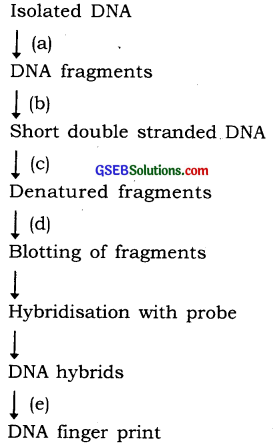
Answer:
a – Restriction endonuclease
b – Gel electrophoresis
c – Alkali
d – Baking .
e – Autoradiography
Question 9.
Note the relationship between the first two words and suggest a suitable word for the 4th place.
a. Purines – Adenine and guanine :: Pyrimidines –
b. AUG – Methionine :: AUC –
c. Operon concept – Jacob and Monod ::
One gene-one enzyme theory –
d. DNA – Thymine and cytosine :: RNA –
e. AUG – initiation codon :: UAA –
f. Xeroderma pigmentosum – Skin cancer :: Retinoblastoma –
g. Semiconservative method of DNA replication – Watson and Crick :: Transformation experiment –
Answer:
a. Cytosine and thymine
b. Isoleucine
c. George Beadle and Edward Tatum
d. Cytosine and uracil
e. Termination codon
f. Cancer of eye
g. Frederick Griffith
![]()
Question 10.
Find the odd one out of the following group.
a. Thymine, Cytosine, Uracil, Adenine
b. RNA primer, DNA polymerase, DNA ligase, DNA transcriptase
c. Initiation, Elongation, Termination, Duplication
d. AUG, UAG, UAA, UGA
Answer:
a. Adenine
b. DNA transcriptase
c. Duplication
d. AUG
![]()
Question 11.
AUG is known as the initiation codon. Give reason.
Answer:
Because AUG initiates the synthesis of protein
Question 12.
What do you mean by central dogma of molecular biology?
Answer:
The unidirectional flow of genetic information from nucleic acid to protein (DNA to RNA and from RNA to protein) is called central dogma of molecular biology.
Question 13.
The following pictures show two personalities which biologists will not forget.
a. Who are they?
b. How did the world honour them for making this contribution?
c. Briefly give details of their contribution to biology.

Answer:
a. A. Watson and B. Crick
b. By giving Nobel Prize
c. James Watson and Francis Crick proposed the double-helical structure model of DNA. According to them, the DNA is formed of two polynucleotide chains. The two chains are spirally coiled together to form a double helix. The two chains are formed by sugar and phosphate and are connected by nitrogen bases. The base pair is always Adenine with Thymine (A = T) and Cytosine with Guanine (C ≡ G). Thus the DNA molecule looks like a spiral staircase with sugar and phosphate units along the railing and the hydrogen-bonded base-pairs as the steps. For this outstanding discovery the science world honoured them by giving Nobel Prize.
![]()
Question 14.
The sequences of nitrogen base in an mRNA are given below. Write down the sequence of nitrogen base in its parent double-strand DNA.

Answer:
TAC CTG GTC ATG AGG GAG
Question 15.
HIV is a retrovirus. Give reason.
Answer:
Because it can synthesise DNA from RNA by a process known as reverse transcription with the help of an enzyme known as reverse transcriptase.
Question 16.
How many non-sense codons are found in 64 codons?
Answer:
Three. They are UAA, UGA and UAG.
![]()
Question 17.
Define the terms cistron, recon, and muton.
Answer:
Cistron – smallest unit of DNA that codes for one polypeptide chain Recon – smallest unit of DNA capable of recombination Muton – small unit of DNA capable of mutation.
Question 18.
What is gene expression? Explain by different methods of gene expression in animals.
Answer:
The mechanism at the molecular level by which a gene is able to express itself in the phenotype of an organism is called gene expression.
Different methods of gene expression in animals are:
- Transduction: It is the process in which bacteriophages pick up pieces of DNA from one bacterial cell and transfer the same to another on the infection.
- Transformation: It is the process by which DNA isolated from one type of cell when introduced into another, is able to bestow some of the properties of the former to the latter.
Question 19.
Match the related items from B and C with column A.
| A | B | C |
| i. Jacob & Monod | a. Genetic code | f. Diplococcus pneumoniae |
| ii. Griffith | b. DNA replication | g. N14 & N15 |
| iii. Meselson and Stahl | c. Transformation | h. Neurospora |
| iv. Beadle and Tatum | d. Operon concept | i. AUG |
| v. Nirenberg and Mathaei | e. One gene-one enzyme hypothesis | j. Structural gene |
Answer:
| A | B | C |
| i. Jacob & Monod | d. Operon concept | j. Structural gene |
| ii. Griffith | c. Transformation | f. Diplococcus pneumonia |
| iii. Meselson and Stahl | b. DNA replication | g. N14 & N15 |
| iv. Beadle and Tatum | e. One gene-one enzyme hypothesis | h. Neurospora |
| v. Nirenberg and Mathaei | a. Genetic code | i. AUG |
![]()
Question 20.
Copy the diagram and label the following parts.
Leading strand, Okazaki fragments, lagging strand, replication points.
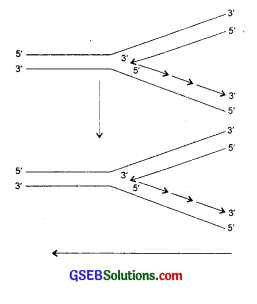

Answer:
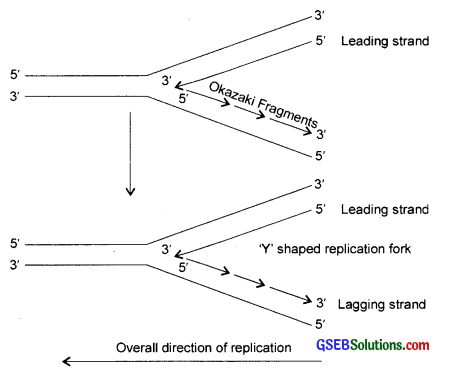
Question 21.
Give one word for the following.
a. Genes that one constantly requires for cellular activities.
b. Sequences of nitrogen bases in mRNA containing the information for protein synthesis.
c. Transcription of DNA from RNA
d. A segment of DNA
e. Synthesis of DNA from pre-existing DNA.
f. Small genetic unit that can mutate
Answer:
a. House keeping gene b. Genetic code
c. Reverse transcription d. Gene
e. Replication f. Muton
![]()
Question 22.
Distinguish between transcription and reverse transcription.
Answer:
Synthesis of RNA from DNA is transcription while the transcription of DNA from RNA is called reverse transcription.
Question 23.
Genetic code is specific and nearly universally justified. (Delhi 2008)
Answer:
Since a codon code only for a particular amino acid, the genetic code is specific or unambiguous. Codon codes for one particular amino acid in all living, be it a bacterium or a human, hence it is universal.
Question 24.
State whether the following statements are true or false. If false write the correct statement’.
a. Thymine and cytosine are pyrimidines.
b. The sequence of bases in a template strand does not determine the sequence of bases in the newly synthesised strand.
c. The new strand formed in a continuous stretch of 5′-3’direction is called lagging strand.
d. m-RNA is like a clover leaf.
e. AUG is a terminating codon.
Answer:
a. True
b. False. The sequence of bases in a template strand determines the sequence of bases in the newly synthesised strand.
c. False. The new strand formed in a continuous stretch of 5’ – 3’ direction is called leading strand.
d. False. mRNA is linear.
e. False. AUG is an initiation codon.
Question 25.
Nowadays cancer-death is increasing day by day. Is this due to the change in living habits?
a. What do you think about this statement?
b. Give some characters of this disease.
c. It is found out that mutation in some genes causes cancer. Justify this statement.
Answer:
a. Yes. Cancer death is increasing day by day
b. 1. Cancer cells are immortal i.e., they show indefinite growth.
ii. Normal constraints of growth are bypassed in the cancer cells
iii. They show metastasis.
c. Yes. Mutation of genes causes cancer. The mutation of proto-oncogenes leads to the formation of oncogenes and which in turn cause cancer.
Question 26.
If the coding region of a gene is estimated to consist of 600 nucleotide base pairs,
a. how many amino acids would the corresponding polypeptide chain contain?
b. Justify your answer.
Answer:
a. about 150
b. Genetic codes are triplet codons.
![]()
Question 27.
The percentage of nucleotide A in DNA isolated from human liver is observed to be 29.6%. What is the expected percentage of T, G and C? Justify.
Answer:
a. T = 29.6%, G = 20.4%, C = 20.4%
b. The amount of A is always equal to T. So the percentage of T is 29.6. G and C together would make up the remainder or 100 – (29.6 + 29.6) = 40.8. Thus the percentage of C and G separately would be expected to be equal or half of 40.8 or 20.4.
Question 28.
The following diagrams are the DNA fingerprints of a child and suspected persons as the father of the child.
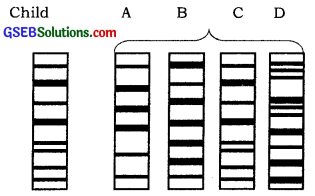
a. Who do you think is the father?
b. How can you identify the father?
c. Write the principle used behind this.
Answer:
a. C – may be the true father.
b. The bands presented is the fingerprints match between child and person C. It denotes that hereditary materials are more or less common in these two bands. Usually a child acquires 50% of hereditary material from his father. So ‘C’ may be the true father of the child.
c. Principle behind it is Variable Number Tandem Repeats (VNTR).
![]()
Question 29.
Match the following.
| A | B |
| i. Human insulin | a. Treat the people having no GTH |
| ii. Interleukin | b. Treatment of viral infection |
| iii. Interferon | c. To enhance the immune system |
| iv. Human growth hormone | d. To treat insulin-dependent diabetes |
Answer:
| A | B |
| i. Human insulin | To treat insulin-dependent diabetes |
| ii. Interleukin | c. To enhance the immune system |
| iii. Interferon | b. Treatment of viral infection |
| iv. Human growth hormone | a. Treat the people having no GTH d. |
Question 30.
Who discovered first the following?
a. Recombinant DNA
b. Totipotency of cell
c. DNA fingerprinting
d. Southern blotting
Answer:
a. P. Berg (1972)
b. Haberlandt (1902)
c. Alec Jeffreys (1985)
d. E.M Southern (1975)
Question 31.
Define the following terms,
a. Genetic engineering
b. Plasmid
c. Vector
d. Transgenic plant
Answer:
a. Genetic engineering deals with the study of manipulation of genes. It involves the artificial synthesis, modification, addition or deletion of genetic material to produce animals or plants with desired quality.
b. Plasmid is the extra chromosomal, circular double-stranded DNA present in the bacterial cells.
c. Vector is a carrier for transferring the selected DNA into cells.
d. The plants produced by incorporating desired genes into their genotypes are called transgenic plants.
![]()
Question 32.
List the objectives of genome project.
Answer:
- To map all the genes in the human genome.
- To determine the sequence of all 3 billion base pairs.
- To store this information in data bases and development tools for data analysis.
- To address the ethical, legal and social issues that may arise from this object.
Question 33.
Name the longest gene.
Answer:
Duchenne muscular Dystrophy (2400 Kilo base pairs)
Question 34.
Give one word for the following.
a. Carbon copies of a single parent
b. Vehicle used to carry gene from one cell to another.
c. Plants or animals produced by incorporating desired genes into their genotype.
d. Technology involves the production of hybrid DNA.
e. Treatment of disease using genes
f. Storehouse of DNA fragments, genes, spores, frozen sperms etc.
Answer:
b. Vector
d. Recombinant DNA technology
f. Gene bank
![]()
Question 35.
Maternity is a fact but sometimes paternity is questionable. We can avoid the dispute connected with paternity. How is it possible? Mention the steps involved in DNA fingerprinting.
Answer:
Using DNA fingerprinting, we can avoid the dispute connected with paternity.
The technique which is used to identify the similarities of the DNA fragments of two individuals is called DNA fingerprinting. It was first developed by Alec Jeffreys (Britain) in 1985. In DNA fingerprinting the DNA molecules are identified by a technique known as Southern blotting, developed by EM Southern in 1975.
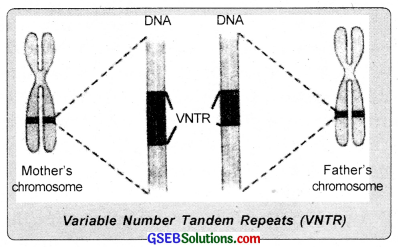
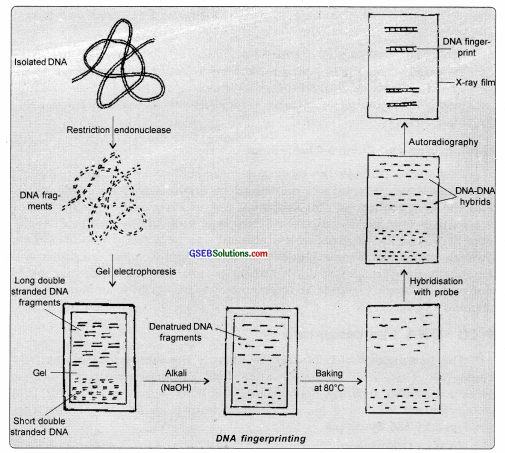
To take DNA fingerprint, repetitive DNA [The human genome contains 3 x 109 (3 billion) nucleotides. A major portion of this comprises a category of non-coding sequences called repetitive sequences. The repetitive sequences vary from person to person. These repeating sequences are also called Variable Number Tandem Repeats (VNTRs)] is isolated from blood, hair or semen. Then it is treated with restriction endonuclease enzyme to cut the repetitive DNA into fragments. Gel electrophoresis is used to separate the fragments. The separated double stranded DNA fragments are then treated with alkali (NaOH).
As a result the double stranded DNA (ds DNA) fragments become single stranded DNA (ss DNA) and denatured. The single stranded DNA fragments are blotted on to a nitrocellulose filter paper and then baked in a vacuum oven at 80°C for 3-5 hrs. This is to the DNA fragment on the membrane. This process is known as blotting. The nitrocellulose filter paper is placed in a solution containing DNA probe (The radioactive labelled single stranded DNA is called DNA probe). The DNA probe binds with the complementary sequences of the DNA fragments on the membrane to form a hybridised DNA. Then the filter paper is washed to remove the unbound probe. The hybridised DNA is then photographed on to an X-ray film by autoradiography. The image of the hybrid DNA obtained by autoradiography is called DNA fingerprint.

Applications of DNA fingerprinting:
- It is used as a powerful forensic tool to solve the problems of paternity (it is known that maternity is a fact, whereas paternity is questionable), rape, murder, etc.
- It is used in the diagnosis of genetic diseases.
- It is used in the determination of phylogenetic status of animals etc.
![]()
Question 36.
Identify the following figure.
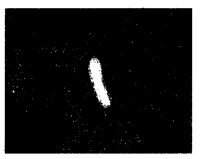
Answer:
Prokaryotic chromosome
Question 37.
Draw schematically a single polynucleotide strand (with at least three nucleotides). Provide labels and directions.
Answer:

A nucleotide has three components – a nitrogenous base, a pentose sugar and a phosphate group. Nitrogenous base is of two types.
- Purines (adenine and guanine)
- Pyrimidines (cytosine, uracil/thymine)
Question 38.
A policeman finds a very small piece of body tissue from the site of a crime and takes it to the forensic department.
a. By which technique will they amplify the DNA collected from the tis sue sample?
b. Mention in a sequence, the three steps involved in each cycle of this technique.
c. What is the role of thermostable DNA polymerase in this technique?
Answer:
a. DNA fingerprinting is very useful technique to identify criminals in the forensic laboratories.
b. i. DNA is cut into fragments with restriction enzymes into precise reproducible sequence.
ii. Separated DNA sequence are transformed on to a nitro cellulose or nylon membrane.
iii. This sequence probes target a specific nucleotide sequence that is complementary to them.
c. DNA is extracted from the cells in a high speed refrigerated centrifuge and many copies of the extracted DNA are made by polymerase chain reaction.
![]()
Question 39.
A few gaps have been left in the following table showing certain terms and their meanings. Fill up the gaps.
| Terms |
Meanings |
| i. ………………….. | The non-coding sequence in eukaryotic DNA technique used in solving paternity disputes. |
| ii. ……………………. | The technique used in solving paternity disputes. |
| iii. Restriction endonuclease | ……………………..…………………….. |
| iv. Plasmid | ……………………..…………………….. |
| v. Transgenics | ……………………..…………………….. |
| vi. …………………….. | Nucleotide sequences with single-base differences |
Answer:
i. Introns – Non-coding sequence in eukaryotic DNA
ii. DNA – Fingerprinting
iii. Endonucleases cut the DNA at specific sites to form fragments with identifiable genes.
iv. An extra – chromosomal DNA molecule that replicates along with the chromosome.
v. The genetically modified organisms containing foreign genes.
vi. RNA
Question 40.

AB and CD represent two strands of a DNA molecule.
When this molecule undergoes replication, a replication fork is formed between A and C in the above.
i. Name the template strands for replication.
ii. Using which strand as the template, will there be continuous synthesis of a complementary DNA strand?
iii. Complementary to which strand will Okazaki segments get synthesised.
iv. What are template strands and Okazaki pieces?
v. In which direction is a new strand synthesised?
Answer:
i. Complementary strands.
ii. One of the template strands with 3’→ 5′ polarity. The synthesis of DNA is continuous. , ‘
iii. Other template strand with polarity 5′ → 3′, the synthesis of DNA is discontinuous, i.e., short stretches of DNA are synthesised.
iv. Template – It is for the synthesis of a new complementary strand. Okazaki pieces: It is discontinuous fragments of DNA. It is Y-shaped fragment.
v. The new strand is synthesised in 5′ → 3’ direction.
![]()
Question 41.
In F. Griffith’s experiment, how did the nonvirulent strain of streptococcus pneumonia become virulent?
Answer:
The nonvirulent becomes virulent strain by acquiring the genetic material of virulent strain.